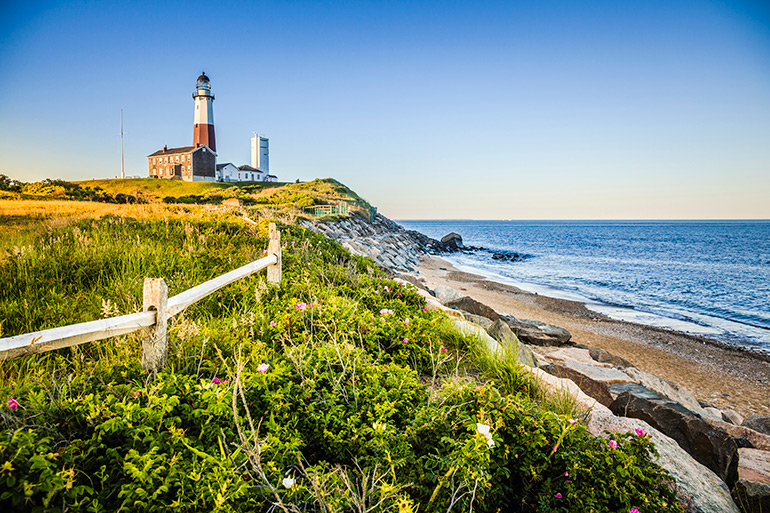Step Off the Beaten Paths of Montauk: Hiking, Culture and More on The End

There are plenty of activities to enjoy in Montauk. The historic Montauk Lighthouse—built in 1796? Check. Any one of its world-famous beaches or restaurants? Check. Check. Culloden Point, where, in 1781 the British HMS Culloden ran aground? Check.
Of course, the place to be in Montauk on the night of Saturday, August 4 will be, without a doubt, the second annual Dan’s Corona MonTaco Oceanside Fiesta hosted and DJ’d by Hannah Bronfman Presented by Mohegan Sun at Gurney’s Montauk Yacht Club. But what’s a body to do before the festivities kick off? Why not explore the historic hamlet a bit more in depth? Learn its history, see the pristine beauty tucked away in unknown spots. Most importantly, have fun—it’s Montauk!

MONTAUK INDIAN MUSEUM
People have lived in what we call Montauk for thousands of years. Like today, they collected clams, fished and feasted on the abundant food resources available to them. This history led the Montauk Historical Society to create a museum to preserve, and present to the public, the history of the original inhabitants of the land. The Museum is designed around the four main segments of Native American history: the Paleo, Archaic, Woodland, and Contact periods. Additionally, artifacts (locally found or reproduced) help visitors understand how Native Americans used high levels of skill and indigenous materials to survive for thousands of years before the arrival of Europeans. Artifacts include pottery, charm stones, crystals, deerskin moccasins, wooden cups that doubled as diggers, pestles used to crush corn and medicinal herbs, axes and tools used to make projectile points including spear points and arrowheads. The Museum is currently open, Thursday–Sunday from noon–3 p.m., and by appointment. montaukhistoricalsociety.org, 631-903-9603

KIRK PARK
The Montauk Village Association maintains this quaint three-acre park, located on the north side of the road just west of the village next to Second House Museum and Montauk Indian Museum. It includes Fort Pond—the second largest freshwater lake on Long Island—a picnic area, a pavilion on Fort Pond (you must walk a gangplank to get to it) and the Kirk Park Trail, a short hike around the southern tip of the pond. Directly across the street is Kirk Pond Beach, in case you want to take a dip.
EDWARD VINCENT ECKER, SR. COUNTY PARK
This park, open year-round, is located at the western end of Fort Pond Bay near Rocky Point. It was formerly known as “Hangar Dock,” as there was a submarine base located there during World War II where torpedoes were tested. In 2003 the park was dedicated in memory of Edward V. Ecker, Sr. for his service as the East Hampton town supervisor, a 55-year member of the Montauk Fire Department, a charter member of the Montauk Ambulance Company and his involvement in the Montauk community.
The park has a parking lot, a deep-water dock suitable for fishing and a rocky beach. This park is perfect for picnics and beach combing, a good place to launch kayaks and canoes, is dog friendly and has easy access to trails in Hither Woods Preserve. 154 Navy Road, Montauk. suffolkcountyny.gov
MONEY POND TRAIL
This trail, approximately one mile long, has two access points: One starts out at to the west of the visitor parking lot and the other is at the halfway point of the Seal Haul Out Trail. You’ll walk through a diverse ecosystem, crossing over creeks, and halfway through,you’ll find yourself at Money Pond, where Captain Kidd legendarily left two chests full of loot. The booty in question hasn’t been found, but that doesn’t mean it isn’t there….

CAMP HERO POINT WOODS LOOP TRAIL
Camp Hero is secret. The park encompasses diverse landscapes, including heavily wooded areas, a long expanse of beachfront along the Atlantic Ocean, maritime forests, freshwater wetlands, and, of course, the historic military installation. An extensive system of trails sprawls throughout the park for hiking, biking and horseback riding. While everyone visits the WWII–era base and its massive SAGE radar tower, most people pack up after that and miss the most spectacular aspect of the park—the bluff overlooking Turtle Cove. To get there, follow the 2.9-mile Point Woods Loop Trail. Along the way you’ll pass ancient beech and oak trees, the remains of old military housing, an intersection with the old Montauk Highway used to take visitors to Montauk Point. Finally, you’ll come to an open field and a bluff 40 feet above the ocean, quite possibly the best view on the entire island.
HITHER HILLS STATE PARK NAPEAGUE BCA
Hither Hills State Park is, like Camp Hero, no secret. What some visitors might be unaware of, though, is the opportunity for bird watching there. The Napeague Bird Conservation Area (BCA) makes up the western portion of Hither Hills. The diversity of breeding birds in the BCA is high, including beach/dune species such as Piping Plover, Least Terns, American Oystercatchers and Short-eared Owls. Roseate Terns and Black Skimmers have bred there in the past. The area around Napeague Harbor is one of the few sites on the East End still occupied by Northern Harriers during the breeding season. The state-endangered/federally threatened Piping Plover nests at Hicks Island, Goff Point and Napeague Beach. If visiting, please be mindful of the birds and remember that most are federally protected.
FORT HILL CEMETERY
Situated on 30 acres overlooking Fort Pond, in the shadow of the historic Montauk Manor, Fort Hill Cemetery is often described by visitors as the most beautiful cemetery they’ve ever seen. The land is believed to be the former site of a 180-square-foot Montaukett fort, hence the name, where a battle took place in 1654—the presumed source of the old remains that have been found there. It’s said that many Montauketts were buried where they died just to the east of Fort Hill following a battle with the Narragansett tribe, which is why that area is sometimes referred to as “Massacre Valley.”
The importance of the land is most evident at Council Rock, a large white quartz rock, once the center of tribal activity for the Montaukett tribe. A plaque on the site notes that tribal meetings were held there, often including representatives of all 13 tribes that inhabited Long Island.









